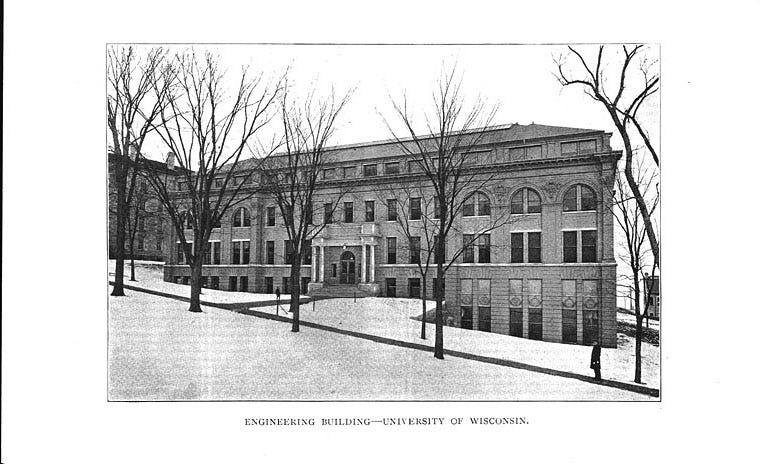By Emily Morzewski

For 120 years, the Wisconsin Engineer Magazine has been a magazine with a mission to document engineering topics that are relevant to the students and alumni of UW-Madison. The Magazine published its first issue in June 1896 with the purpose of establishing a journal to share the knowledge and experiences of the students of what was then called the College of Mechanics and Engineering. The Magazine was first and foremost a method of communicating experiences before the time of social media.
Over the course of its long history, the Magazine has reported on groundbreaking technology from the boom of the automotive industry to the rise of commercial flight, and more recently, expeditions in space. In the 120 years that the Magazine has been in publication, the progress of technology and engineering has been tremendous. What is considered normal in our everyday lives today was, at one time, breaking news. In the very first issue published by the Magazine, many of the articles dealt with the then-relevant technology in the railway system with titles such as, “A comparative test of a compound and single expansion locomotive,” and “Storage battery auxiliaries for railway power stations.”
Like any art form, major world events have shaped the Magazine into what it is today. When the United States entered World War I, the writing staff of the Wisconsin Engineer turned to topics such as submarine navigation, the technology behind the navigation processes, and other wartime technology. In the April 1917 issue, John G. Callan aptly titled his article “Submarines,” which explained “The essential advantages of the submarine lie in its invisibility and in the extreme deadliness of the torpedo.” To a modern audience, these facts may seem particularly mundane, but at the time, the submarine was the pinnacle of military technology. The Wisconsin Engineer kept the public informed on the technology that was keeping our country safe.
After World War I, the Magazine continued to report breakthrough technology and issues important to the times. As the country descended into the heart of the Great Depression, the Magazine reported on the engineering projects across the U.S. that were essential to rebuilding the economy. In the November 1929 issue of the magazine, an article by Professor Daniel W. Mead focuses on the proposed construction of dams along the Colorado River. “The dam, if built, will be the highest dam yet constructed and will be more than twice the height of the Arrowrock Dam which is now the highest dam built,” Mead explained in his article.
Moving ahead in history to December 1941, a letter from College of Engineering (CoE) Dean F. Ellis Johnson was featured in the Magazine following the attacks on Pearl Harbor. In his statement, he called for the men of the CoE to strive to achieve perfect grades because in a time of total war, competency in all areas was key. “It is only thus that we may leave to others after us the principles which shall make the freedom and opportunities we win for men worth the total war we must wage,” wrote Ellis. As the Second World War continued, articles regarding the Army Corps of Engineers were featured in many issues. In the November 1943 issue, a piece titled “Engineers Behind the Guns,” by P.F.C. Karl Wegener detailed how the outcome of a war is no longer determined by well-trained men, but rather that “modern war” calls for engineers to develop the best equipment and to be well-trained in combat. Men don’t win wars, he claimed, technology does.
It was during this tumultuous era that the first trace of women’s involvement in the Magazine appeared. In the April 1943 issue, Loella Niles wrote an article entitled “Women Workers,” which documented how women were taking over traditionally-male jobs as more and more men left the factories for the war. This extended into all fields of work, including engineering. Following the publication of this article, women slowly became an integrated part of the Magazine’s staff.
The Magazine is and always has been a product of its times, reflecting world events and capturing ideas and feelings permanently into text. Over the years, the Magazine staff has not only shared feats of engineering, but has also tackled social issues of the times. The Magazine even included obituaries, book reviews, jokes, and puzzles. During the Civil Rights Movement of the 1960s, there was a noticeable shift in the way articles were approached and written, as the magazine staff started to adapt to the changing social scene. Additionally, a “Feedback” section was added to the Magazine so the readers could voice their concerns about articles in the prior issues or provide ideas for articles.
As the written content and reporting style of the Magazine evolved over the past 120 years, the visual content did too. The earliest illustrations were simple pencil drawings and sketches. As technology improved, photography became more prevalent in the Magazine. The advent of television and the internet also allowed the Magazine to progress. The Magazine now has a strong social media presence as well as a website. Media has transformed the way the Magazine has grown, yet it still holds true to the founders’ intents: publishing material that matters to engineers.
Looking through the past articles it is evident this publication became much more than just a place to share engineering accomplishments, but a place to document life experiences. Each issue of the Magazine is a time capsule that captures the thoughts, ideas, and dreams of generations long gone. Those who came before the current staff of the Magazine carved a monumental path, and during the next 120 years, the Magazine will continue to report the evolution of technology, creating snapshots of the voices of our generation.
Check out the Wisconsin Engineer Magazine archives here discover more of the history that the magazine has preserved.
